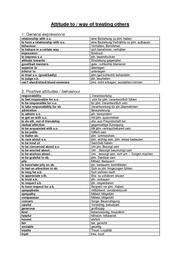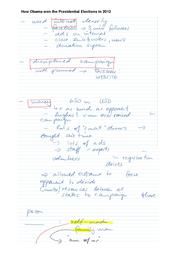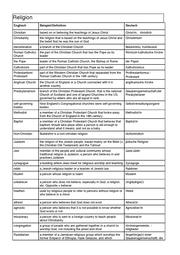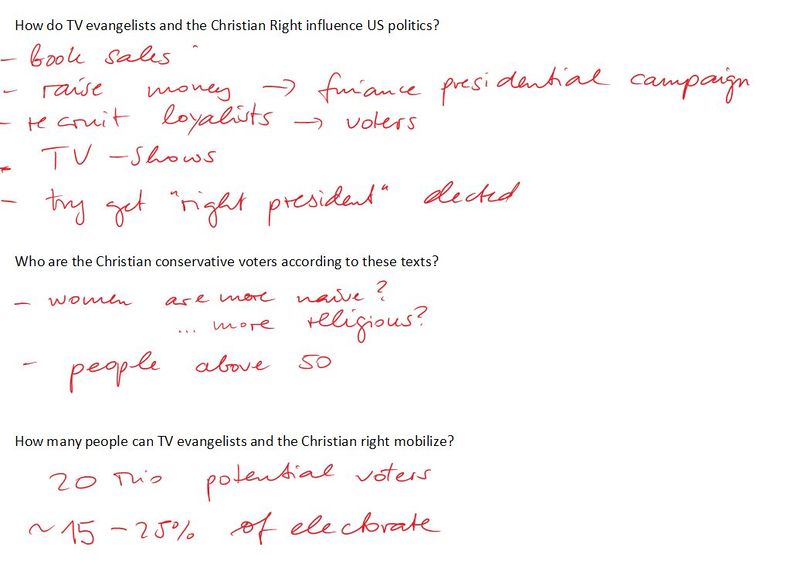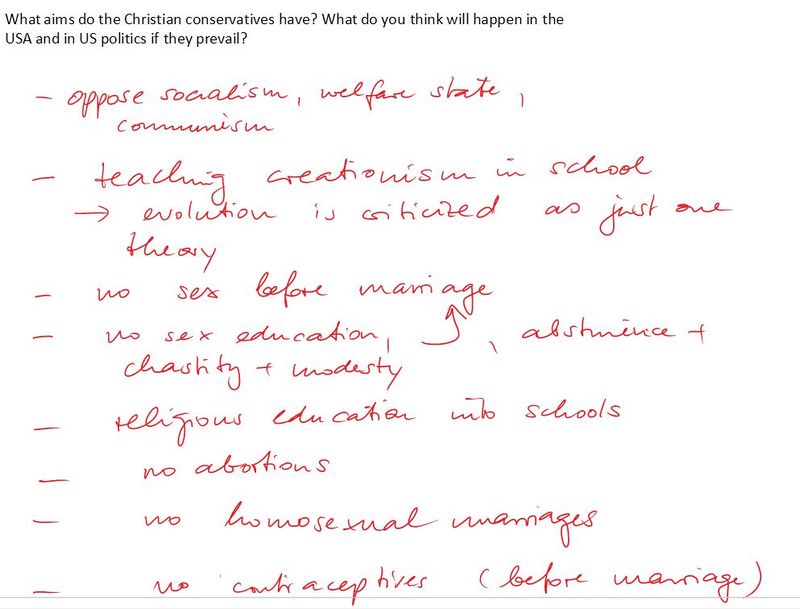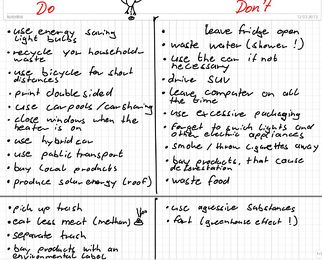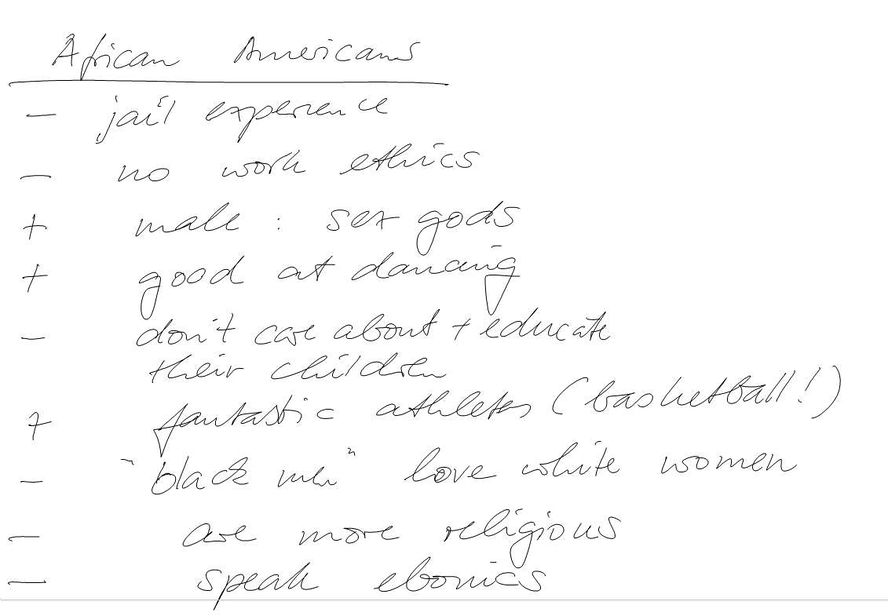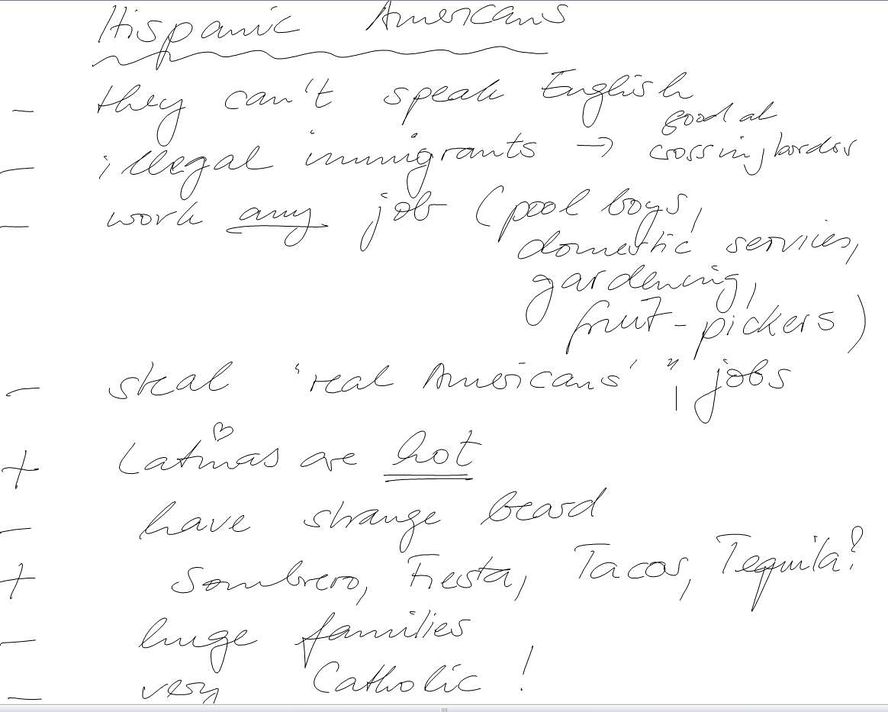Thelenberg 2011 12
|
Aktuelles Vokabeltest
|
Homework
- Wenn dein Nachname mit einem Buchstaben von A - L beginnt ⇒ Task A
- Wenn dein Nachname mit einem Buchstaben von M - Z beginnt ⇒ Task B
TASK A: Stereotypes against African Americans
Positive or negative ..? - what effects?
- Have a look at this article! "Black men are ..."
Task B: Stereotypes against Hispanic/Latino Americans
Positive or negative ..? - what effects?
- Have a look at this article! Hispanics are ...
Recent Homework
- What stereotypes about Asian Americans are there? Make a structured list (sex, positive/negative ...)
- What effect do these stereotypes have on the way they are treated by others? Develop theories for at least 4 of the stereotypes you found!
- What is the topic and message of this song?
- How does the artist try to sell his message cleverly? Look at the images and lyrics (To say what part of the video you are talking about, use the timecode, e.g. 3:32)
- What phrase/image do you like?
- How does it work?
- What rhetorical tricks are used?
How green are you?
- Look at How green are you?
- Look through the test again an create a simple list of dos and don'ts!
- Prepare a short talk about at least 4 environmental dos and don'ts and tell people about your favourite!
- Look at the cartoon on welfare recipients!
- Write a short descrption and analysis!
- Give some thought to what is criticized and how people/attitutudes are shown to be wrong/absurd
- Translate the elements in the cartoon into real objects (e.g. man stands for embittered public feeling they worked hard but now get a small pension)
1. Watch the Film "Where Angels fear to Tread" from minute 6:40 - 9:00!
- how is the scene from the book put into film? (what is the same, what is different?)
- are the characters played well - or what does not fit? (judged on the basis of the dialogue in the book/text we read)
- do the characters + their behaviour, expression, speech fulfill your expectations or not?
2. Look at + learn this Definition of "Class"
Comment on this statement:
Although British Muslims make only about 5% of the population, many Britons fear the lslamization of Britain and speak of a "war" and the need for immediate self-defence.
- Look at this before you write your comment!
Watch minutes 1:00 - 16.00 and 27:30-35:06 of this video!
- What strikes you as different/interesting/positive/strange about the family and life of the Amish the teenagers stay with?
Describe and interprete this cartoon!
Watch the video at least two times!
- What are the children taught to do?
- What /who is "the enemy"?
- How are they convinced/taught to believe/to act as the are supposed to?
Religion and Politics and the Christian Right
Look at your homework (book, p. 80/81) and the worksheet on TV Evangelism and the Views of the Christian Right!
- How do TV evangelists and the Christian Right influence US politics?
- Who are the Christian conservative voters according to these texts?
- How many people can TV evangelists and the Christian Right mobilize?
- What aims do the Christian conservatives have? What do you think would happen in the USA and in US politics if they prevailed?
Watch the video at least two times!
Collect facts about:
- Lakewood "Megachurch"
- Joel Osteen's message
- the "Services"
- financial matters
What is your impression of Osteen and his church?
Why do you think is his church growing so fast?
Explain for three groups/people/events from our blog:
- What person/group/historical event?
- What is the link between them and Obama's Slogan "Yes we can!"
Be prepared to give a three minute talk!
Watch Obama's full speech in 2008 here + identify tricks/rhetorical devices, effective/crucial phrases/emotions ... (+ give timecode, e.g. 1:40).
Use this mindmap to find features that make this speech effective.
- For Friday: Describe+Analyse this cartoon!
- Work on 2nd part of worksheet on Presidential elections (Electoral College) using SQR Method!
- Add useful phrases (E+D) to list of vocab from Wiki (cf US Politics on this page)
Basic Skills & Information
- Information on homework and oral grades
- Reading and Marking technique - SQ3R Method A useful method to read, mark and annotate texts.
- Working with Cartoons
- A good speech/speaker ...
- Answering questions on the text
- Starting a paragraph
- Starting an Essay/Comment
- Writing an interview
- Mediation
- Translation (E→G)
- Characterization
- Building an Argument
US Political System
How Obama won the presidential elections in 2012
The summary of the lessons on this topic can be found in this PDF.
Useful Vocabulary
| Committee | Komitee, Ausschuss |
| politicians | Politiker |
| declare ones candidacy | Kandidatur ankündigen |
| campaign | (Wahl-)Kampagne |
| key states | Schlüsselstaaten |
| the primaries | die Vorwahlen |
| to pledge | sich verpflichten, schwören |
| delegate | Deligierter |
| the party convention | Parteitag |
| running-mate | ein Kandidat für die Vizepräsidentschaft |
| rival | Rivale / Konkurrent |
| state-by-state | staatenweise/ Staat für Staat |
| campaigning | |
| swing states | Bundesstaat mit hohem Wechselwähleranteil |
| televised debate | Fernsehdebatte |
| Voters | Wähler |
| electors | Wahlmann |
| electoral college | Versammlung aller Wahlmänner |
Religion in the USA and Britain
Vocabulary
Cartoon
.
Facts on Religion and Politics in the US
Special Religious Groups and Institutions
- (Evangelical) Mega-Churches
- church should not play the role of the state, but have clear positions
- against stem cell research
- against gay marriage
- against abortion
- some are liberal in enforcing their views
- 7,500 seats in church
- 11,000 congregants
Trends
- 72% of the Americans want their president to be clearly religious
- majority says churches should not endorse candidates
- half of the Americans think churches should express views on political matters
- 41% of the Americans want more religion in politics
- Americans are comfortable with showing their faith in public
- vote for candidates who aren't afraid to express their religious views
- only about 30% of Americans refuse gay marriage in 2003 - as compared to 41% in 1996
- about 25% are white evangelical christians and vote republican
- so many Americans believe that religion should not have any direct influence on and US politics but believe in religion being a privately exercised, individual matter
- many American Christians are not evangelicals and clearly want a more liberal, open-minded idea of Christianity and belief in God
Typical aspects/facts concerning religion in the USA
- US constitution strictly separates church and state
- US politicians - unlike their counterparts in Europe - often mention God in their speeches (God bless you, God bless America ...)
Influence of the Christian Right in the US
Cf. Book, p. 80/81
- Majority of conservative judges at US Courts appointed by Bush - hope for Religious Right?
- Religious Right fails at forcing schools to do school prayer and teach intelligent design.
- Religiously motivated influence on US Foreign Policy
- Most states forbid gay marriage while Washington refuses to include ban in Constitution
- Christian Right successful with ban on new stem cell research
- Supreme Court still rejects display of religious symbols in public institutions
TV Evangelism & Lakewood Megachurch
Watch the video at least two times!
Collect facts about:
- Lakewood "Megachurch"
- Joel Osteen's message
- the "Services"
- financial matters
What is your impression of Osteen and his church?
Why do you think is his church growing so fast?
Download Summary of facts about Osteen's megachurch
The Amish in the USA
Facts about the Amish (mainly from)
different about life, family:
- transport+farming with horses, mules
- work from dawn to dusk
- hard physical work: baling hay, picking beans + tomatoes
- animals are highly valued
- 6 children
- girls' dresses è modesty ...
- day starts with reading from the bible
- homeschooling (to be with them, not to lose contact, really educate them ...)
- work-ethic of children
- family/time with children valued very highly
- modern technology is not accepted if it threatens to break up the family or community or link the Amish too closely to the world outside - but "independent" gas refrigerators or a small generator just for the washing machine are allowed in some groups.
- Look at text1 and text2! They contain good information about the Amish
- Write an interview with an Amish!
- Start with a short characterization of the person you interview (name, appearance, why/when/where interview is done).
- Structure: question and answer form. Use interesting questions, make sure the answers fit the questions.
- Language: Make sure the register/style of interviewer and interviewee are appropriate (they may be different!) Remember to use "spoken language"!
- Last step: careful proofreading
- The interview should cover the topics of
- electricity
- using cars
- the clothes they wear
- attitude to tourists and being photographed!
Creationism
- Short summary of the text.
Muslims in Britain
Texts
- Problematic issues between British Muslims and the "Christian" majority
- A problem of perception: Muslims are well-integrated in Britain – but no one seems to believe it
- Reflections of a Former Islamist Extremist
- Read from beginnin to "And it's a very powerful grip on one's mind. And in my case it took years to shed that influence." (third box)
- Answers to book, p. 86/87 q. 5 + 6
- Why does a young muslim turn into an extremist?
- crucial event: death of thousands of European muslims in war in Bosnia in 90s! West just watches and doesn't help the muslims there. (Parallels to wars in Iraq .... muslims are being killed and no-one cares)
- Islam is cleverly presented as way of looking at history: like in Marxism it is always a struggle, them against us, bad against good, everybody against the muslims (idea of Western/Jewish conspiracy against Islam/muslims)
- at school/in university young muslims become part of an active, organized, outspoken movement ⇒ proud to be an active muslim, feeling of power, feeling of belonging to group and of changing the world.
Cartoon ⇐Klick!
- 4 frames, three show acts of violence/hatred committed in the name of Christianity/Western Civilization
- evangelical pastor [=church] burning Korans, evangelical/conservative politician [politics] against building mosque in USA, secret service agent [=government] torturing terrorist suspect)
- irony: they all want revenge/act as unchristian/intolerantly as those they accuse of doing this to them
- irony: preacher is completely stupid: of course "them folks don't act like Christians" - they simply aren't christians!
- preacher also doesn't seem to know his Bilble: "Jesus hates Mohammed" is absolutely like anthing Jesus preaches in the Bible: Jesus preaches love, peace and forgiveness - not hatred!
- picture four shows the result: children in USA have learned, that you needn't act as you wish others to act towards you (in civilized way, mercyfully, helpfully, tolerantly ...) but can do anything you want as long as nobody stops you.
- General criticism: christian/western preachers and politicians and governments do the same things they accuse terrorists and radical islamist of ⇒ they are no better than them
Society and Class
Hierarchy of needs - and the role of the individual in society
Class and Society in Victorian England
Questions on the text
- Try to characterize the two protagonists!
- How does the narrator influence the readers feelings towards the characters? (Give lines)
- What different attitudes towards class and marriage can you identify? (Give lines)
Watch from 6:40 to 9:00!
Definitions of "Class"
| Victorian Society = 3 classes: upper, middle, and lower/working |
|---|
|
Upper class = nobility, or peerage (dukes, earls, viscounts)
|
Welfare in the USA
- Look at the cartoon on welfare recipients!
- Write a short description and analysis!
- Give some thought to what is criticized and how people/attitutudes are shown to be wrong/absurd
- Translate the elements in the cartoon into real objects (e.g. man stands for embittered public feeling they worked hard but now get a small pension)
Welfare reform in the USA 1996 (cf book, p. 16/17)
Available Benefits
- cash welfare benefits
- Medicaid
- food stamps
- disability benefits
- TANF – Temporary Aid for Needy Families
| reasons | welfare reform 1996 - changes | effects of 1996 welfare reforms |
|---|---|---|
|
|
|
Talks
- Use your own words! (You may include some short, illustrating/fitting quotations ...)
- Write clear statements or questions and answers! Show and explain contrasts, problems, developments, cause and effects .....
- Use your computer's spellchecking!
System of Welfare in the USA (Hemmerlein)
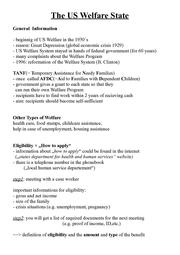
|
Criticism of Welfare, its recipients and its effects (Keupp)
Defence of Welfare and the people that depend on it (Brandl)

|
Welfare in Britain
- Watch the short video on Welfare in Britain twice.
- Take notes
Try to identify/explain
- the causes and effects of so many people being on welfare
- why it is so difficult to get people off welfare
- what measures are taken to achieve this
Ecology and Protecting the Environment
How green are you?
- Look at How green are you?
- Look through the test again an create a simple list of dos and don'ts!
- Prepare a short talk about at least 4 environmental dos and don'ts and tell people about your favourite!
Environmental DOs and DON'Ts
Zum Vergrößern mehrfach klicken und dann speichern ...!
Ethnicity, Immigration and Racism
Stereotypes
- ... are fixed, simple ideas or images that many people have of a particular type of person or thing
- ... often use simple criteria and give a simplified version of reality
- ... help us to categorize/distinguish between dangerous and harmless, attractive and unattractive, relieble - treacherous ...
- ... help us to understand and explain the world in a quick and simple way
- ... can be positive (men are strong) and negative (men don't have true feelings)
- ... are often very hard to change, even if experiences suggest thtat the stereotype may be wrong/to simple to explain complex realties or individual behaiviour
Stereotypes against Asian Americans
What stereotypes about Asian Americans are there? Make a structured list (sex, positive/negative ...)
- Men
- + clever, hard working
- + technology-freaks, good with computers
- - nerds
- - not masculine/effeminate
- - not athletic
- - short
- Women
- + exotic (sexually attractive)
- + clever, hard working
- + submissive/demure
- - too clever(for many men), tricky
What effect do these stereotypes have on the way they are treated by others? Develop theories for at least 4 of the stereotypes you found!
Stereotypes against African Americans
Positive or negative ..? - what effects?
Stereotypes against Hispanic/Latino Americans
Positive or negative ..? - what effects?
A clever Way of Addressing racism ...
- What is the topic and message of this song?
- How does the artist try to sell his message cleverly? Look at the images and lyrics (To say what part of the video you are talking about, use the timecode, e.g. 3:32)
- What phrase/image do you like?
- How does it work?
- What rhetorical tricks are used?
The dream that made them come: The American Dream!
American Life - Madonna
